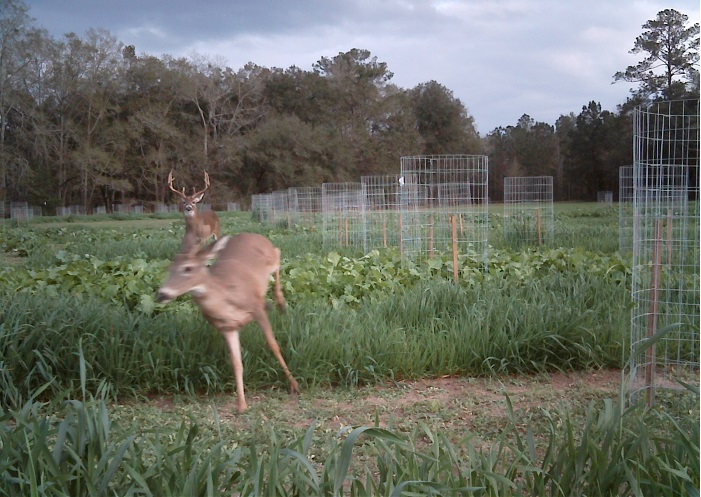
by Mark Mauldin | Nov 7, 2016

A buck chases a doe through plots of wildlife forages being evaluated in 2013 at the University of Florida’s North Florida Research and Education Center. Photo Courtesy of Holly Ober
It should be too late in the year for an article about cool season food plots; they should already be up and growing, at the very least planted. It’s November, archery season has begun, the fall food plot ship should have already sailed. However, due to the incredibly dry weather we’ve had for the past several months I hope that ship hasn’t sailed. I hope you have not planted your food plots yet. The tristate area is dry, too dry to plant anything you expect to survive. If you have not already planted, don’t until your area gets substantial rain.
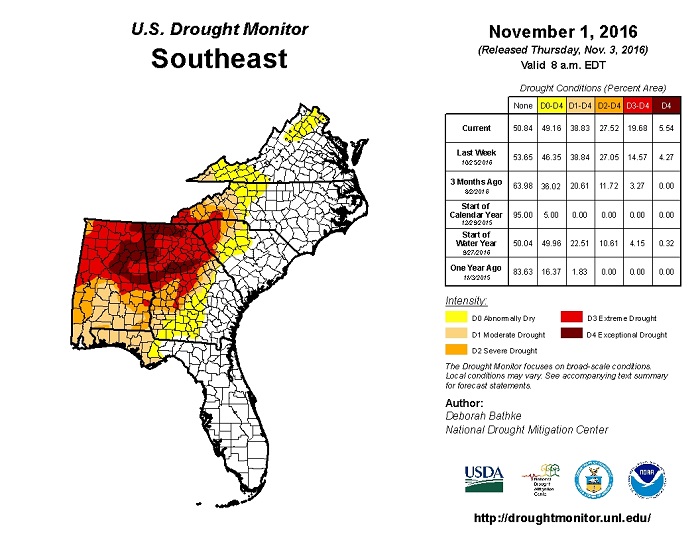
Very dry conditions persist across the Southeast.
The saying goes “The best time to go hunting is whenever I have time”. As the classic weekend-warrior sportsman myself, I can easily relate to that saying and I can also understand how/why folks would apply that same logic to planting food plots. Unfortunately, with this fall’s weather that logic does not hold true. Any plantings made before we have adequate moisture run a very high chance of being complete failures.
These likely failures can playout in a variety of ways but they all end the same. Seedlings have tiny roots systems, moisture must be accessible very near the soil surface in order for them to access it. If moisture is unavailable in the tiny root zone the seedlings will wilt. Wilting greatly diminishes the plants ability to carry out photosynthesis; no photosynthesis no energy. Seedlings have virtually no stored energy to fall back on, so the seedlings begin to die rapidly.
Admittedly, I left out one key detail in the plant horror story above; moisture is required for seed germination. If it is dry enough seeds can be planted and nothing will happen – they won’t germinate, they won’t try to grow, they won’t die from lack of moisture. This fact leads some to conclude, “Plant now and it will come up whenever it rains”. While there is some sound logic in that conclusion, it is a very risky plan when you consider the types of plants we typically include in our wildlife plots. “Dusting in” as it is called in the crop world, can work with larger seeded, deeper planted crops. It is not well suited to small seeded, very shallow planted forages like clover. When a seed is right at the soil surface the tiniest amount of rain or even a heavy dew could provide enough moisture for germination which would likely start the process I described earlier.
The safest bet is to wait until your area has received a good soaking rain and there is a favorable chance for additional rains. As dry as we are now, that first ½ inch shower will not provide adequate moisture for establishment if it is followed by an extended period without additional rain.
Sooner or later it will rain (I think), so you wind up planting your plots later than normal. What does that mean? In the grand scheme of things, not much. As we get later in the year the days get shorter and the air and soil temperatures get lower which can slow the development of the plants. That said, the real growth for most of our cool season forages really occurs in the spring and that will still be that case regardless of if you planted in October, November or December. Remember the goal of food plots should be increasing the quality and quantity of forage available for wildlife throughout the entire year.
The dry weather has messed up food plot establishment as it relates to hunting season but if all you wanted was a game attractant for hunting purposes food plots were probably not your best bet in the first place. It takes considerable time, effort and expense to maintain quality food plots, to the point that they are really not a very practical option if only viewed as an attractant for a few months out of the year.

If attracting deer, not improving habitat, is your primary goal you might consider establishing a feeding station. Be sure to check FWC regulations before you begin feeding game animals.
Be patient, wait for the weather conditions to improve before planting. There is no point in wasting your time and money on plantings that have a very low chance of being successful. Contact your county’s agriculture or natural resources agent for more details relating to the establishment of wildlife plots.
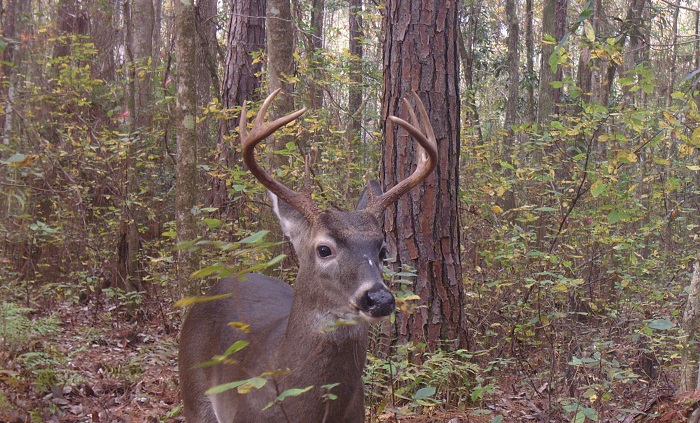
by Jennifer Bearden | Oct 31, 2015
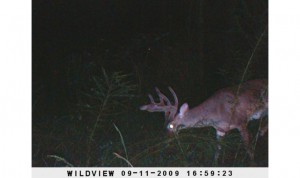
Deer in velvet. Photo by Jennifer Bearden
When hunting, food safety begins in the field. The goal is to have safe meat for you and your family to eat. Here are a few ways to keep your food safe:
- Shot placement – that’s right. Food safety begins with an accurate shot. Your goal should be to prevent the contents of the digestive tract from touching the meat. A gut shot can quickly ruin meat and make cleaning the animal harder.
- The quicker you get the meat chilled the better. Improper temperature is meat’s number one enemy. The recommended storage temperature to prevent bacterial growth is 35-40°F.
- Handle the knife with one hand and the carcass with the other. The hide can harbor dirt and pathogens so care should be taken to prevent contamination of the meat.
- Have vinegar water and chlorine water on hand. Vinegar water (50/50) can be sprayed on areas where hair or hide touch the meat. Rinse hands and tools periodically in a bucket of sanitizing solution of 1 tbsp of chlorine per gallon of water.
- Think food safety through the whole process. Prevent cross contamination by keeping anything from contacting the meat unless it has been sterilized. Keep the digestive tract intact and prevent the contents of it from contacting the meat. Chill the meat as quickly as possible. When further processing, continue to use sterile surfaces and tools.
For more information on wild game processing safety, you can attend our upcoming Wild About Deer: Game Processing Program on November 14 from 10am to 2pm. We will teach processing safety from field to table. A home-cooked venison meal will be provided. The cost is $20. Please pre-register by calling 850-689-5850.
Wild about Deer Flyer

by Mark Mauldin | Aug 21, 2015

Deer hunting season is just around the corner. It’s time to start scouting and making preparations to plant cool season food plots. Photo Credit: Mark Mauldin
The temperature might still be in the 90s but the kids are back in school and football season is starting soon; that means fall is coming and with it, the beginning of hunting season. Here in northwest Florida archery season for deer and turkey begins October 24. While it might still be a little early to dust off your camouflage there are still plenty of things you can be doing this time of year to get ready for the start of hunting season.
If plan to utilize food plots on your hunting property this fall it is time to take soil samples and if need be, apply lime. All plants have a soil pH range where they grow best. For many of the plants we commonly use in food plots the ideal range for soil pH is above that of our soils here in Florida. Applying lime to the soil will increase the soil pH, but it takes time; months not weeks. There are a variety of liming products available but the most economical option is generally bulk, agricultural or dolomitic lime. Ideally lime would be incorporated into the soil well before planting. A soil test will provide specific recommendations about how much lime and fertilizer your site needs. Your county extension agent can assist you in submitting a soil sample for analysis and interpreting the results and recommendations. Soil pH greatly effects soil nutrient availability; spending money on fertilizer without checking or correcting the pH is not advisable.
It is still early to plant cool season food plots; planting should begin around October 1. It is not too early to begin researching what you want to plant and booking seed. If you are particular about what varieties you want to utilize (you should be) you should make arrangements with seed suppliers in advance. Always be sure to utilize crops and varieties that are well suited to your site. Be careful with premixes that are sold at chain stores. These products may not be well suited to our environment here in Florida. Contact your county agent and be on the lookout for future articles for more information on selecting the forage crops that are best suited to your area.
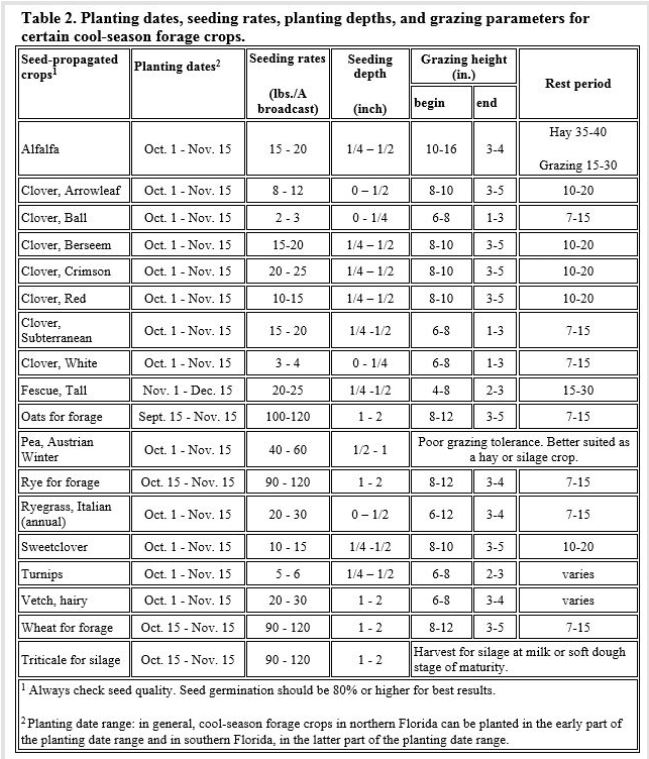
Chart from: 2015 Cool-Season Forage Variety Recommendations for Florida
By; Ann Blount, Patricio Munoz, Jose Dubeux, Joao Vendramini, Ali Barbar, Kevin Kenworthy, and Ken Quesenberry
If you are planning on hunting over feed (corn, etc.) you should have already began your feeding program. To legally hunt over feed the feeding station must have been maintained with feed continuously for at least six months prior to harvest game in the vicinity. In other words, if you start feeding corn today (8/20) you can’t legally hunt over it until February 20th. For more information regarding hunting over feed see the FWC webpage.
Using game cameras to monitor your property can help you get an idea about the quantity and quality of animals utilizing your property. Having this information before hunting season can help you plan management decisions in advance. Preseason scouting, on foot or with game cameras can also help you determine what parts of your property game are utilizing the most. Granted, there is still plenty of time for patterns to change before hunting season gets here. Another positive aspect of utilizing game cameras this time of year is that they give you an added excuse to spend a little extra time in the woods. In the months leading up to hunting season going to “check cameras” is somewhat of a Sunday afternoon tradition in my house.
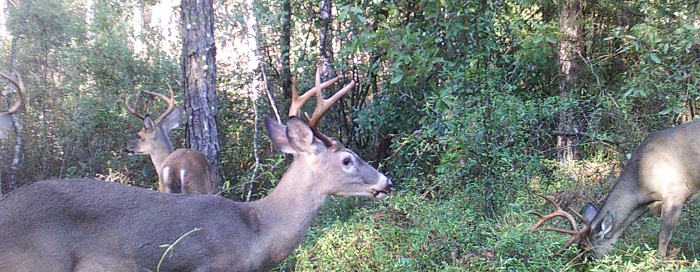
Dense summer foliage and a bachelor group of NW Florida bucks can make for a fun game camera photo. How many bucks can you find? Photo Credit: Mark Mauldin
Long summer days give you plenty of time in the evenings to practice shooting your bow. Proficiency with a bow takes practice and repetition. I was once told, “Don’t practice until you can hit what you’re aiming at, practice until you can’t miss”. Practice now, don’t wait until you miss, or worse, wound an animal to realize you needed to improve your skills. In addition to working on your skills for hunting season, archery can be great outdoor fun for the entire family.
There are a lot of hot days to wait through still ahead of us but hunting season is coming; if you’re like me you’ll be happy to see it when it gets here. Now is the time to make plans and preparations so when the waiting is finally over you’ll be able to have your best season yet.
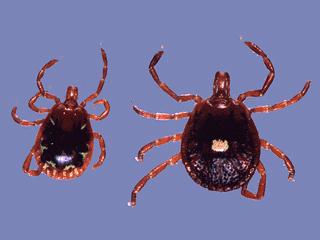
by Jennifer Bearden | Dec 13, 2013
This fall remains mild despite a couple of recent frosty mornings.
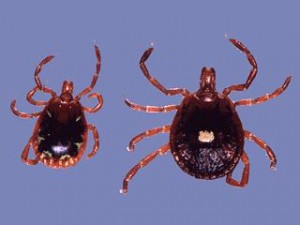
Lone Star Ticks carry Southern Tick Associated Rash Illness. Photo Courtesy of UF/IFAS Communications
With mild temperatures comes ticks. Ticks carry and transmit several diseases.
Brown dog ticks are found mainly on dogs and can carry Rocky Mountain Spotted Fever.
American dog ticks are also usually found on dogs but will also attach to other mammals and humans. They also can transmit Rocky Mountain Spotted Fever. American dog ticks can cause paralysis when they attach to the base of the skull or spinal column. Recovery usually occurs within 24 hours of tick removal.
Gulf Coast Ticks are similar to the American dog tick with larger mouthparts. They transmit a less severe relative of Rocky Mountain Spotted Fever. Gulf Coast Ticks are commonly found on the ears of large mammals such as horses and cattle.
Lone Star Tick is the most common human-biting tick in Florida. They transmit Southern Tick Associated Rash Illness which is similar to Lyme disease.
Black-legged tick, also called deer tick, is most commonly known as the carrier of Lyme disease.
Here are a few ways to prevent tick-borne illnesses:
- Remove ticks as soon as possible
- Wear light colored clothing so ticks can easily be seen
- Keep all clothing buttoned, zipped and tucked-in
- Use Repellents with 20-30% DEET on exposed skin
- Apply Permethrins to clothing and allow them to dry before wearing
- Avoid brushing against plants in tick-infested areas
- Clear brush along pathways and walk in the middle of pathway
If you are bitten by a tick or develop symptoms, contact your physician. Early diagnosis is best and makes treating tick disease easier and more effective.
[youtube=http://www.youtube.com/watch?v=tbIn_cxTlJQ]
by Brooke Saari | Mar 5, 2013
National Invasive Species Awareness Week: March 3rd – March 8th
March 5th: Wild Hogs (Sus scrofa) & Water Hyacinth (Eichhornia crassipes):
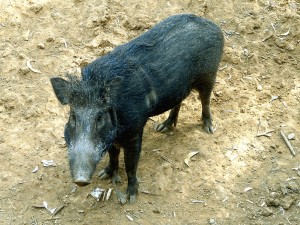
Wild boar Photo Credit: Florida Fish & Wildlife Conservation Commission
Wild Hogs: Wild Hogs, also called Feral Hogs, are not native to the United States. Wild hogs are highly adaptable and can find suitable habitat easily. They are very prolific. Females have multiple litters of 3-8 piglets per year. Wild hogs are opportunistic omnivores that feed by rooting and grazing. The impact of wild hogs on the environment is soil erosion, decreased water quality, spread of other invasive plants, damage to agricultural crops, and damage to native plants and animals. Wild hogs pose a health risk to humans because they can carry numerous diseases and parasites. Human hunting is the most significant cause of mortality in wild hogs, although hunting alone will not eradicate hogs from a given habitat. The most effective way to remove wild hogs from a location is a combination of trapping and shooting. For more information on Wild Hogs, go to: http://edis.ifas.ufl.edu/uw322
For more information contact the author Jennifer Bearden, Agriculture Extension Agent, 850-689-5850.
Water Hyacinth: The water hyacinth is a floating non-native plant, which if left unchecked and allowed to grow to its maximum potential,
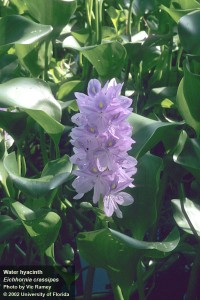
Water Hyacinth Photo Credit: Vic Ramey, UF
can weigh up to 200 tons per acre of water. Once it gets into rivers, it can choke out other vegetation and make navigation difficult if not impossible, because the plants will grow intertwined and form huge floating mats that can root on muddy surfaces. Water hyacinth is a wolf in sheep’s clothing—it is a highly ornamental plant. The plant will be several inches tall with showy lavender flowers and rounded, shiny, smooth leaves. These leaves are attached to spongy stalks that help keep the plants afloat. The prolific roots are dark and feathery. Although here in northwest Florida most of it dies back in the winter, it is able to regrow when the weather and water warm up. This weed can be controlled by physical removal, through biological control options—water hyacinth weevils will be useful in keeping the plant populations down—and by chemical means. For more information on hyacinth and other weed control in Florida ponds, please see the UF IFAS publication Weed Control in Florida Ponds. If you have any questions about identifying a pond weed, contact your friendly local county Extension agent.
For more information contact the author Libbie Johnson Agriculture Extension Agent, 850-475-5230.













